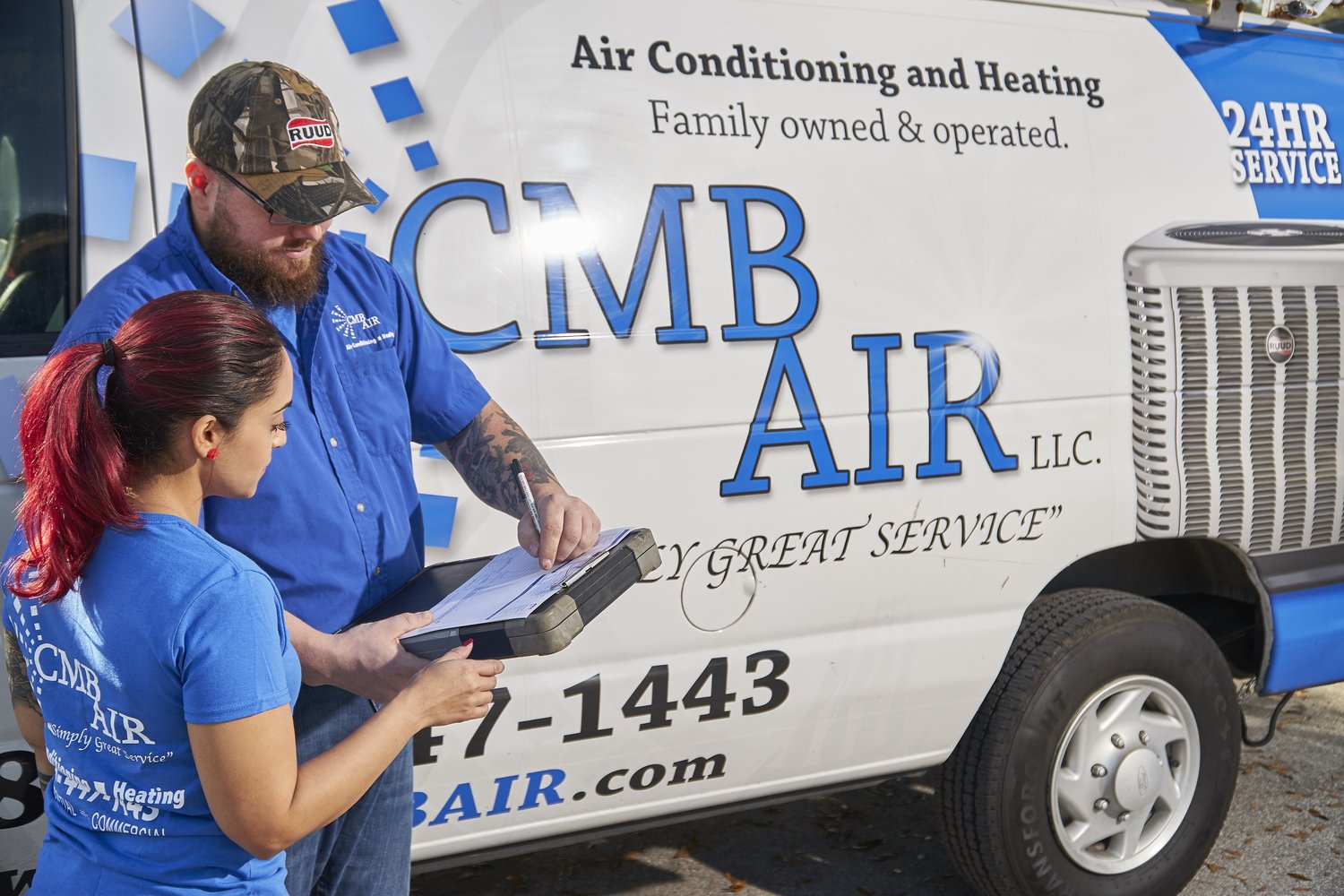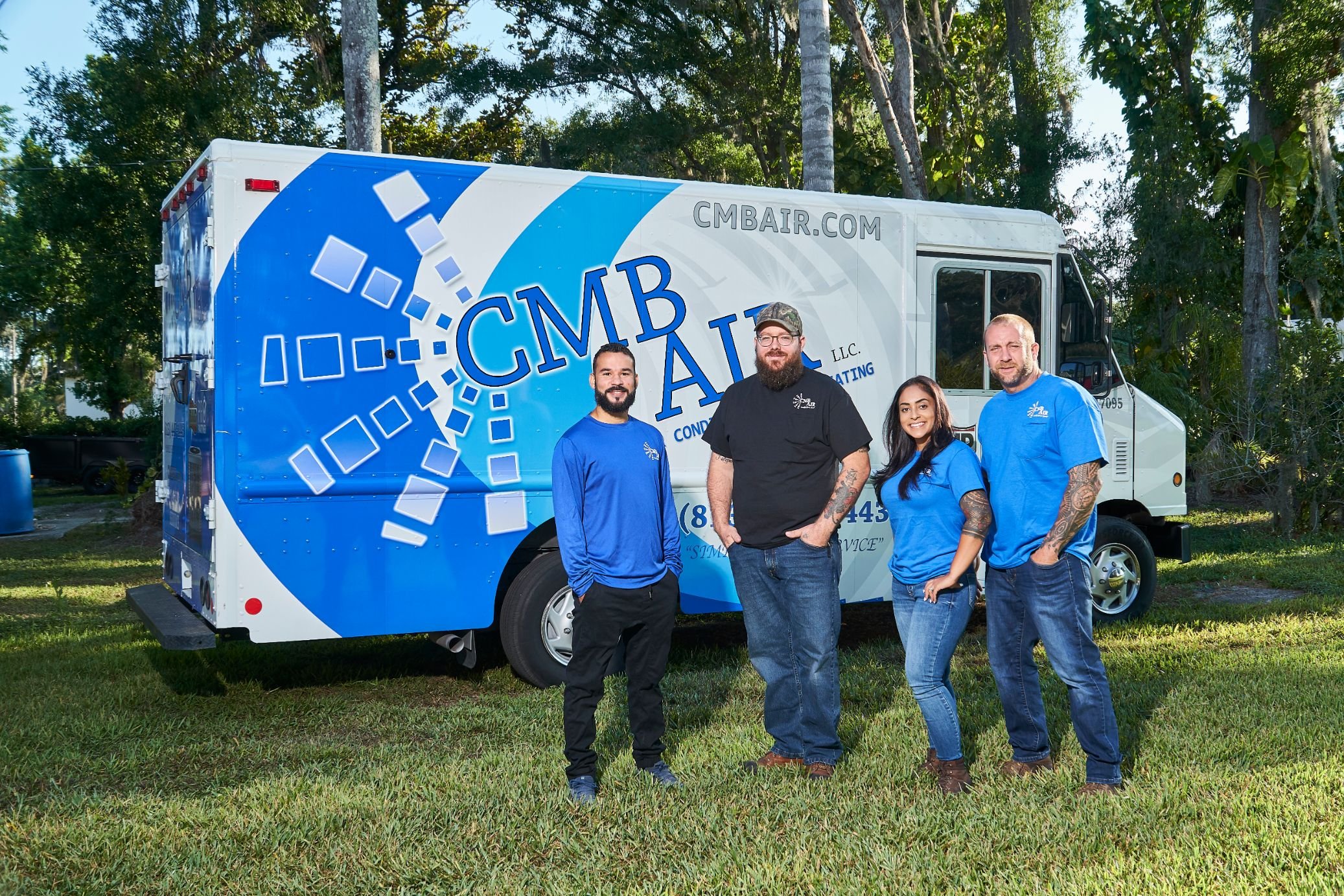
Furnace Heat Exchanger Repair and Replacement in Tampa, fl
The furnace heat exchanger is a critical component of a heating system, responsible for transferring heat from the combustion chamber to the air circulated through the home. The heat exchanger heats up during operation as combustion gases pass through it. As the blower fan blows air over the heated exchanger, the air absorbs the warmth before being distributed through the ductwork and into the living spaces. This process ensures efficient heating of the home while minimizing energy waste.
-
Over time, wear or other factors lead to cracks or damage in the heat exchanger. These cracks can allow combustion gases, including carbon monoxide, to leak into the air circulated throughout the home, posing a serious health risk. In such cases, furnace heat exchanger repair or replacement becomes necessary to ensure the safe and efficient operation of the heating system. Professional HVAC technicians, like those at CMB Air, can inspect the heat exchanger for damage and recommend the appropriate action to restore the furnace's functionality and protect the household’s health and safety.
Benefits of Timely Heat Exchanger Service in Tampa, Fl
-
Promotes safety from carbon monoxide leaks
Regular heat exchanger maintenance prevents dangerous carbon monoxide from entering living spaces through cracks or deterioration. Professional inspections identify potential failure points before they become safety hazards. Modern testing methods detect microscopic damage that could lead to harmful gas leaks. Our certified technicians use specialized equipment to verify the structural integrity of this critical component, maintaining a safe home environment throughout the heating season.
-
Restores furnace efficiency and performance
Professional heat exchanger service optimizes heat transfer from combustion gases to household air. Clean, well-maintained exchangers transfer heat more effectively, reducing fuel consumption and operating costs. Regular service removes buildup that can impede heat transfer and strain system components. This maintenance restores the furnace's ability to heat spaces quickly and maintain consistent temperatures throughout the home.
-
Extends the furnace's lifespan
Proper heat exchanger maintenance reduces stress on other components by maintaining efficient operation. Regular service prevents accelerated wear when heat exchangers become compromised or dirty. Professional maintenance includes cleaning and inspecting related components to support overall system longevity. This comprehensive approach to heat exchanger care protects the substantial investment in heating equipment.
-
Avoids costly future repairs
Proactive heat exchanger maintenance identifies potential issues before they become significant. Regular inspections catch small cracks or wear patterns that could lead to complete system failure. Professional service prevents problems that can occur when heat exchanger issues go unaddressed. This preventive approach saves money by addressing minor issues before they require extensive repairs.
-
Improves indoor air quality
Well-maintained heat exchangers prevent combustion byproducts from mixing with household air. Regular service removes accumulated debris that could affect air quality when circulated through the home. Professional maintenance includes inspection of air filtration systems and ventilation components. This attention to air quality helps maintain a healthy indoor environment during the heating season.
Our Furnace Heat Exchanger Repair Process in Tampa, Fl
-
Our experienced technicians begin with comprehensive testing to evaluate heat exchanger condition and performance. We employ advanced diagnostic tools to detect cracks, corrosion, or other damage that could compromise safety or efficiency. The assessment includes examining related components and airflow patterns affecting heat exchanger function. This detailed evaluation guides our recommendations for repair or replacement options.
-
We implement strict safety protocols throughout the heat exchanger repair to protect technicians and residents. Our team uses specialized equipment to monitor air quality and gas levels during all repair procedures. Professional safety practices include proper ventilation and isolation of work areas during repairs. These precautions maintain a secure environment while completing necessary maintenance work.
-
Our certified technicians follow manufacturer specifications and industry standards when repairing heat exchanger components. We use appropriate materials and techniques to address identified issues while maintaining system integrity. The repair process includes carefully examining seals and connections affecting heat exchanger operation. Our methodical approach restores proper function while preventing future complications.
-
We conduct extensive testing following repairs to verify heat exchanger performance and safety. Our testing protocol includes multiple operating cycles to confirm proper heat transfer and combustion. We measure temperature differentials and analyze exhaust gases to validate repair effectiveness. This thorough evaluation confirms that all safety and efficiency standards are met before returning the system to service.
Choose CMB Air for Heat Exchanger Services in Tampa, Fl
Licensed and experienced HVAC technicians
Our team brings decades of combined experience in heat exchanger repair and maintenance across all major furnace brands. Each technician maintains current certifications and undergoes regular training on emerging HVAC technologies and repair techniques. We pride ourselves on our team's ability to diagnose complex issues accurately and implement effective solutions. Our technicians' expertise extends beyond basic repairs, including comprehensive system analysis and preventive maintenance recommendations based on extensive field experience.
Use of certified parts and tools
We partner with leading manufacturers to source genuine replacement parts that meet strict quality standards. Our service vehicles carry comprehensive inventories of commonly needed components to expedite repairs. The specialized diagnostic equipment we use undergoes regular calibration to maintain accuracy. Our investment in professional-grade tools allows our technicians to complete repairs efficiently while meeting manufacturer specifications for installation and testing.
Commitment to customer safety
Our service protocols prioritize protecting residents and property throughout every heat exchanger repair. We conduct thorough carbon monoxide testing before and after all heat exchanger services. Our technicians follow detailed safety checklists and maintain proper ventilation during all repair procedures. Our documentation includes safety certifications and testing results for complete peace of mind.
Transparent pricing
Our detailed service quotes break down all heat exchanger repair or replacement costs. We discuss repair options and associated expenses before beginning any work. The pricing structure clearly explains parts, labor, and warranty coverage. Our commitment to transparency extends to documenting all completed work and recommendations for future maintenance.
Quick and reliable service
Our scheduling system prioritizes heat exchanger issues to minimize waiting times for essential repairs. We maintain flexible appointment availability to accommodate emergencies. Our efficient diagnostic procedures allow us to identify problems quickly and begin necessary repairs promptly. The comprehensive nature of our service prevents callback visits and provides lasting solutions to heat exchanger issues.
Our Reviews
Customer care is our priority.

Signs of Heat Exchanger Problems in Tampa, Fl
Recognizing signs of heat exchanger problems is crucial for maintaining a safe and efficient heating system. Common indicators of heat exchanger issues include the presence of carbon monoxide, visible cracks in the heat exchanger, and unusual odors emanating from the furnace during operation. Carbon monoxide, a colorless and odorless gas, can be detected by carbon monoxide detectors or through symptoms such as headaches, nausea, dizziness, or flu-like symptoms experienced by occupants. Visible cracks in the heat exchanger can sometimes be seen during a visual inspection, while unusual odors, such as a burnt or metallic smell, may indicate combustion problems.
Taking prompt action upon noticing these signs is essential to prevent potential risks associated with heat exchanger malfunctions. A damaged heat exchanger can lead to the release of carbon monoxide into the home's air supply, posing serious health hazards to occupants, including carbon monoxide poisoning, which can be fatal. Additionally, a compromised heat exchanger can affect the furnace's efficiency and performance, leading to increased energy consumption, higher utility bills, and potentially costly repairs or premature furnace replacement.
By recognizing these signs and promptly addressing heat exchanger issues, homeowners can ensure the safety and well-being of their household members and preserve the longevity and reliability of their heating system. Professional inspection and repair by qualified HVAC technicians, such as those at CMB Air, can identify and resolve heat exchanger problems effectively, restoring the furnace's functionality and providing peace of mind to homeowners and surrounding areas.
We proudly serve…
Tampa, Ballast Point, Brandon, Carrollwood, Citrus Park, Davis Islands, Downtown & Channelside, Harbour Island, Hyde Park, New Tampa, NOHO, Northdale, Palma Ceia, Seminole Heights, SOHO, South Tampa, Tampa Heights, Tampa Palms, Temple Terrace, West Tampa, Westchase, Westshore, Ybor City, Lutz, Odessa, Oldsmar, Land O Lakes, Wesley Chapel, Eagles Neighborhood Subdivision/ Eagles Community Tampa, New Port Richey, Palm Harbor, Dunedin, Brandon, Riverview, Valrico, Cheval, Van Dyke Farms, Citrus Park, TOWN 'N' COUNTRY, OLDSMAR, LUTZ, & NORTHDALE, Terrace park, palmetto beach, Riverside Heights, Woodland terrace, Jackson heights, sunset park, bon air, oak park, riverbend, Plaza terrace, rivergrove, bayshore gardens, virginia park, westshore palms, parkland estates, belmont heights, robles park, college hills, forest hills, and surrounging areas
Heat Exchanger Inspection and Diagnosis in Tampa, Fl
Heat exchanger inspection and diagnosis are critical components of furnace maintenance, and it's essential to hire a qualified HVAC technician for this task. A skilled technician possesses the expertise and tools necessary to thoroughly examine the heat exchanger for signs of damage or deterioration. Visual inspection involves checking for visible cracks, corrosion, or other signs of wear that could compromise the integrity of the heat exchanger.
-
Furthermore, diagnostic testing is conducted to confirm heat exchanger issues and identify the underlying cause. This may include performing combustion analysis to assess the furnace's efficiency and safety, as well as using specialized tools to detect the presence of carbon monoxide or other combustion byproducts. Additionally, pressure testing may be performed to check for leaks or weak spots in the heat exchanger.
Hiring a qualified HVAC technician for heat exchanger inspection and diagnosis is essential for several reasons. Firstly, technicians have the training and experience to identify potential problems accurately, ensuring that issues are addressed promptly to prevent safety hazards or further damage to the furnace. Additionally, technicians have access to specialized tools and diagnostic equipment that enable them to conduct thorough assessments and provide accurate diagnoses.
Overall, hiring a qualified HVAC technician for heat exchanger inspection and diagnosis is crucial for ensuring the furnace's safety, efficiency, and reliability. By entrusting this task to a skilled professional, homeowners can have confidence in the integrity of their heating system and enjoy peace of mind, knowing that potential issues have been identified and addressed effectively.
Heat Exchanger Replacement in Tampa, Fl
Heat exchanger replacement is a significant aspect of furnace maintenance, particularly when the existing heat exchanger is damaged beyond repair. The process typically involves several steps to ensure the safe and effective installation of a new heat exchanger.
Firstly, the HVAC technician will assess the furnace to determine the appropriate replacement heat exchanger based on the furnace specifications and compatibility. This involves selecting a heat exchanger that matches the furnace's size, capacity, and other technical specifications to ensure proper fit and performance.
-
Once the replacement heat exchanger is selected, the removal of the old heat exchanger begins. This often requires disassembling parts of the furnace to access the heat exchanger, which may be located within the combustion chamber or near the blower assembly. Careful attention is paid to disconnecting electrical and gas connections to ensure safety during removal.
After the old heat exchanger is removed, the new heat exchanger is installed. This involves securely attaching the new heat exchanger to the furnace chassis and reassembling any components that were removed during the removal process. Proper alignment and sealing are crucial to ensure optimal performance and prevent air or gas leaks.
Once the new heat exchanger is installed, the HVAC technician will perform thorough testing to ensure the furnace operates safely and efficiently. This may include conducting combustion analysis, pressure testing, and other diagnostic tests to verify the integrity of the new heat exchanger and the furnace's overall functionality.
In summary, heat exchanger replacement is a complex process that requires careful planning and execution to ensure the safe and effective operation of the furnace. By selecting a suitable replacement heat exchanger and following proper installation procedures, homeowners can maintain the integrity of their heating system and enjoy reliable warmth and comfort in their homes.
If a furnace heat exchanger in Tampa requires repair or replacement, homeowners should consider CMB Air for reliable and professional service. With a team of skilled technicians and a commitment to customer satisfaction, CMB Air ensures prompt and effective solutions to address heat exchanger issues.
FAQ’s on furnace heat exchanger in Tampa, Fl
-
It transfers heat from the combustion process to the air circulated in your home.
-
Causes include age, overheating, and poor maintenance.
-
Minor cracks can sometimes be sealed, but severe damage requires replacement.
-
Costs typically range from $500 to $2,500, depending on the furnace and part quality.
-
Signs include unusual odors, illness symptoms, or carbon monoxide detector alerts.
-
Usually 2-4 hours, depending on the complexity of the job.
-
No, it poses serious risks, including carbon monoxide leaks.
-
If the furnace is old, replacing the entire unit might be more cost-effective.
-
Annual inspections during furnace maintenance are recommended.
-
Yes, we provide 24/7 emergency repair and replacement services.
